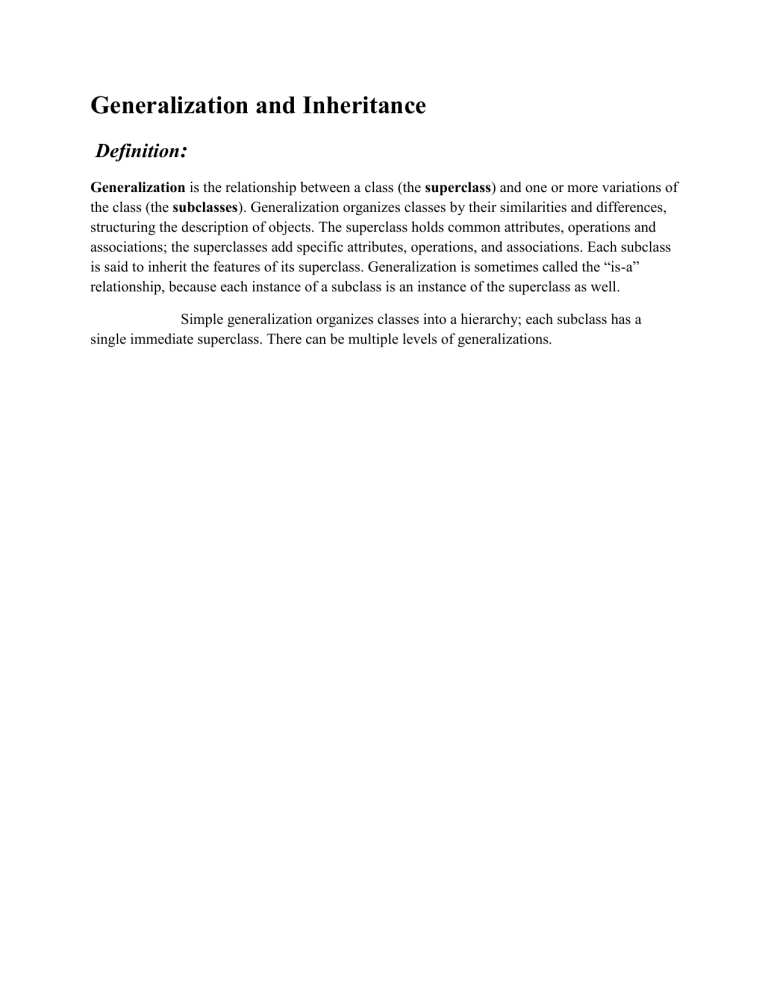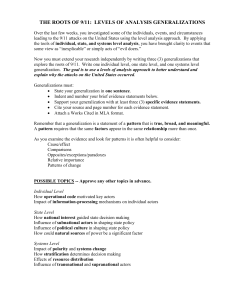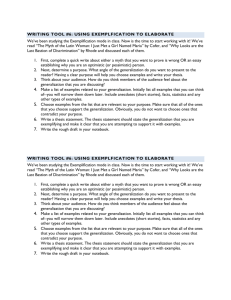Chapter 3 & 4- Generalization, A Sample Class Model

Generalization and Inheritance
Definition
:
Generalization is the relationship between a class (the superclass ) and one or more variations of the class (the subclasses ). Generalization organizes classes by their similarities and differences, structuring the description of objects. The superclass holds common attributes, operations and associations; the superclasses add specific attributes, operations, and associations. Each subclass is said to inherit the features of its superclass. Generalization is sometimes called the “is-a” relationship, because each instance of a subclass is an instance of the superclass as well.
Simple generalization organizes classes into a hierarchy; each subclass has a single immediate superclass. There can be multiple levels of generalizations.
Figure 3.24 shows several examples of generalization for equipment. Each piece of equipment is a pump, heat exchanger, or tank. There are several kinds of pumps: centrifugal, diaphragm, and plunger. There are several kinds of tanks: spherical, pressurized, and floating roof. The fact that the tank generalization symbol is drawn below the pump generalization is not significant. Several objects are displayed at the bottom of the figure. Each object inherits features
from one class at each level of the generalization. Thus P101 embodies the features of equipment, pump, and diaphragm pump. E302 has the properties of equipment and heat exchanger.
A large hollow arrowhead denotes generalization. The arrowhead points to the superclass. You may directly connect the superclass to each subclass, but we normally prefer to group subclasses as a tree. For convenience, you can rotate the triangle and place it on any side, but if possible you should draw the superclass on top and subclasses on the bottom. The curly braces denote a UML comment, indicating that there are additional subclasses that the diagram does not show (Figure 3.24).
Generalization is a transitive across an arbitrary number of levels. The terms ancestor and descendant refer to generalization of classes across multiple levels. An instance of a subclass is simultaneously an instance of all its ancestor classes. An instance includes a value for every attribute of every ancestor class. An instance can invoke any operation on any ancestor class. Each subclass not only inherits all the features of its ancestors but adds its own specific features as well. For example, Pump adds attributes SuctionPressure, dischargePressure , and flowRate, which other kinds of equipment do not share.
Figure 3.25 shows classes of geometric figures. This example has more of a programming flavor and emphasizes inheritance of operations. Move, select, rotate, and display are operations that all subclasses inherit. Scale applies to one-diamensional and twodiamensional figures. Fill applies to one-diamensional figures. (figure 3.25)
The word written next to the generalization line in the diagram— diamensionality
—is a generalization set name. A generalization set name is an enumerated attribute that indicates which aspect of an object is being abstracted by a particular generalization. You should generalize only one aspect at a time. For example, the means of propulsion and the environment are two aspects for class Vehicle . Generalization set values are inherently in one-to-one correspondence with the subclasses of a generalization. The generalization set name is optional.
Use of Generalization
:
Generalization has three purposes, one of which is support for polymorphism.
Polymorphism increases the flexibility of the software—you add a new subclass and automatically inherit superclass behavior. Furthermore, the new subclass does not disrupt existing code. Contrast the OO situation with procedural code, where addition of a new type can cause a ripple of changes.
The second purpose of generalization is to structure the description of the objects.
When you use generalization, you are making a conceptual statement—you are forming a taxonomy and organizing objects on the basis of their similarities and differences. This is much more profound than modeling each class individually and in isolation from other classes.
The third purpose is to enable reuse of code—you can inherit code within your application as well as from past work. Reuse is more productive than repeatedly writing code from scratch. Generalization also lets you adjust the code, where necessary, to get the precise desired behavior. Reuse is an important motivator for inheritance, but the benefits are often oversold.
The terms generalization, specialization, and inheritance all refer to aspects of the same idea. Generalization and specialization concern a relationship among classes and take opposite perspectives, viewed from the super class or from sub classes. The word generalization derives from the fact that the superclass generalizes the subclasses. Specialization refers to the fact that the subclasses refine or specialize the superclass.
Inheritance is the mechanism for sharing attributes, operations , and associations via the generalization/specialization relationship.
Overriding Features:
A subclass may override a superclass feature by defining a feature with the same name.
The overriding feature (the subclass feature) refines and replaces the overriden feature (the superclass feature). In figure 3.25 each leaf subclass must implement display , even though
Figure defines it.Class Circle improves performance by overriding operation rotate to br null operation.
You should never override the signature, or form, of a feature. An override should preserve attribute type, number and type of arguments to an operation return type. Tightening the type of an attribute or operation argument to be a subclass of the original type is a form of restriction and must be done with care.
A subclass is a special case of its superclass and should be compatible with it in every respect. A common but unfortunate, practice in OO programming is to “borrow” a class that is similar to a desired class and then modify it by changing and ignoring some of its features, even
though the new class is not really special case of the original class. This practice can lead to conceptual confusion and hidden assumptions built into programs.
A Sample Class Model





